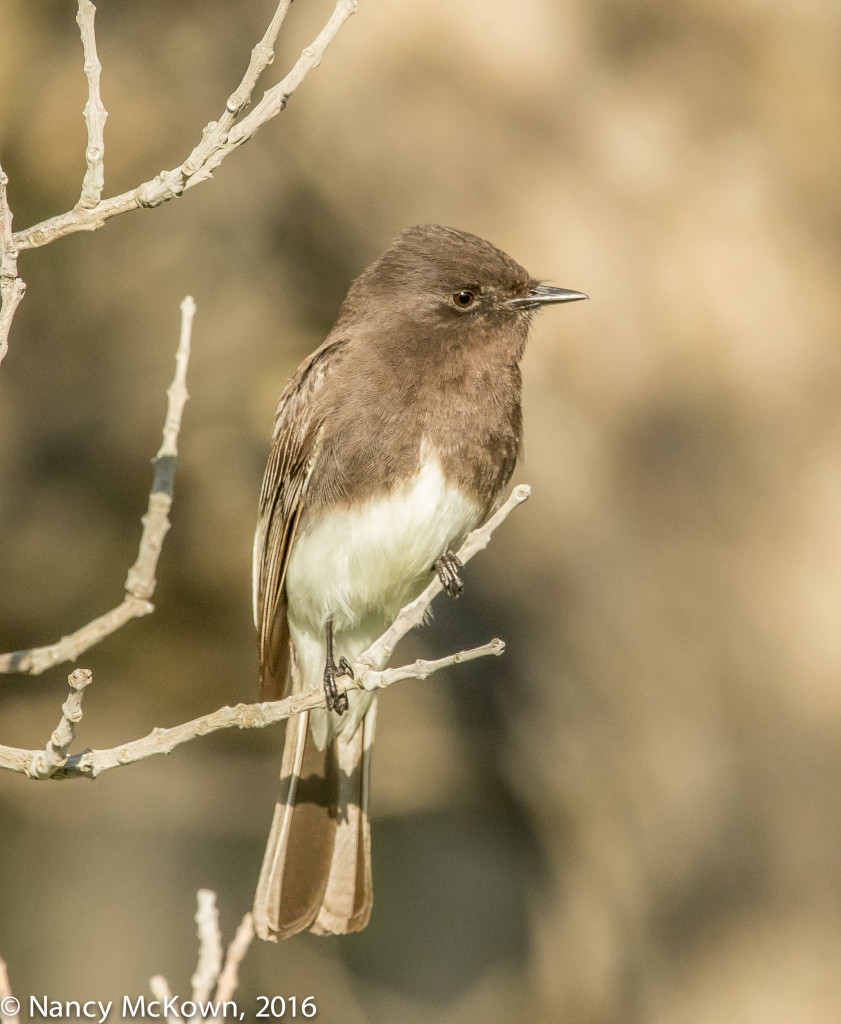Photographing Black Phoebes
Most mornings, I’m up early enough to greet the dawn. It’s not always sunny, but I still get excited thinking about photographic prospects that may come with the glorious morning light.
One recent morning in sunny San Diego, I woke to a cloudy gray morning with no promise of favorable light for bird photography. I decided to scout around for possible locations that might offer the likelihood of engaging sun-set lit images.

Plumage is More Brown than Black.
ISO1600; f/8; 1/1250 Second
Dawn v Dusk
At dawn, soft luminosity rapidly intensifies into a day long burst. The light seems cleaner, clearer with warm colors embellished by the mist in the air. Moving from darkness into light, my eyes do not struggle to adapt. But sunset feels entirely different. Vision rapidly declines as light fades quickly to murky gray. My impaired vision struggles to discern birdish contours in the diminishing light. Once the sun dips below the horizon, there is only enough light for silhouettes.
Sunset Lit Black Phoebes
Bird photography is always a waiting game, but it has been my experience that birds are more actively foraging during the early morning hours. On this particular evening, a few aerobatic Black Phoebes swooped up, down and around, catching flying insects while airborne. They momentarily rested on lower tree limbs, quickly pounced on unsuspecting ground quarry, then reclaimed their perches to swallow and prepare for the next strike.
I stood with my tripod fairly close to the activity, approximately 8 feet away. (Minimum focusing distance for the Canon 300mm f/2.8L II IS Lens = 78.7″) Long shadows extended in front of the camera…. so much so that I had to move the equipment further back so my shadow did not obstruct light on the subject in front of me.
Wildlife Activity Down
When I searched out possible sunset shooting locations that morning, I saw a lot of potential in way of light and bird activity. I did not however, factor in the influence people have on the behavior of wildlife. Ordinarily, very few people are around to disturb the early morning calmness. Thirty minutes before sunset when I set up my camera and tripod, people were everywhere.
I should have known. Birds were scarce because people generated road and foot traffic was up. Most of the human transients ignored me and continued with their activities and conversations, but some stopped to stare, walked over to investigate the area where the camera was pointing, or just walked by in front of the camera.

ISO1250; f/8; 1/1250 Second
Sunset Success
It didn’t take long before the sun’s angle was low enough to flood the Black Phoebe straight on with soft and flattering light (except for a few branch shadows on the tail feathers). The creamy brown bokeh is the result of light intermingling with densely packed wooded tree trunks. Thankfully, there was a good 12 feet between my subject and his background. This distance helped achieve a seamless blur despite using a fairly tight aperture – f/8 – on my Canon 300mm 2.8 L IS lens with 1.4 telephoto attached. I think this rich background contrasts nicely with the subject and helps bring out the detail in the bird’s plumage.
NOTE: “BOKEH = noun, a Japanese term for the subjective aesthetic quality of out-of-focus areas of a photographic image.” No matter how visually appealing, Bokeh is wasted on an image that doesn’t have an interesting subject and composition.








